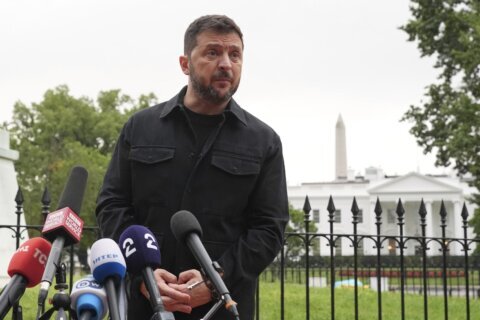WASHINGTON — ISIL leader Abu Bakr Al-Baghdadi nearly died within the last year.
“That brush with mortality allowed him to come to the conclusion [that] he’d better be more aggressive in putting people around him to survive,” said Mike Rogers, former chairman of the House Intelligence Committee.
Rogers wouldn’t specify when and where the near-death experience took place. “That event, how dangerously close it came to taking his life, was probably a motivator for him to change the way he’s doing his command and control,” Rogers tells WTOP.
It seems there have been several close calls for Baghdadi. In November 2014, U.S. Central Command confirmed that it executed airstrikes near Al Qaim, Iraq, that heavily damaged or destroyed four ISIL vehicles and struck four of its buildings.
Baghdadi was believed to have been in one of the structures. He was wounded during a meeting with militants in Qaim, according to a statement from Iraqi Defense Minister Khalid Obeidi.
Another time, media reports claim, he was seriously wounded in mid-March when an air strike killed three men he traveled with. The attack took place in al-Baaj, roughly 75 miles west of Mosul.
Unconfirmed reports emerged suggesting he died after that strike, but U.S. military and intelligence officials said two weeks ago they had high confidence he was still alive.
Officials believe ISIL is moving aggressively to make sure it can operate without him. The group “has a redundant leadership structure,” a U.S. defense official told WTOP. “If we killed the leader of a particular province, he’d be replaced in 24 hours.”
Baghdadi hasn’t appeared in front of a general audience since July 2014, when he gave a speech from a mosque in Mosul. His disappearance came shortly after the U.S.-led coalition strikes began. “You get that close to somebody, that’ll wake them up in the morning,” Rogers said.
The Obama administration has been criticized for not taking a more aggressive role to eliminate ISIL. That’s tough to do and it won’t happen right away. “Our mission to destroy ISIL and to keep our country safe will be difficult,” President Obama said at the Pentagon in July. “It will take time. There will be setbacks as well as progress.”
At times, that progress has been stymied because of ISIL’s next-man-up philosophy.
“It’s true they have a bench and we’re not ignorant about that,” said National Security Council spokesman Alistair Baskey. “Irrespective of that, we’re going to go after their leadership, so that they know they are not safe.”
ISIL has quickly filled holes in its mid-level leadership and shown it can repair infrastructure targeted by U.S. airstrikes, according to the defense official.
“It’s a well-run organization,” the official said. “They keep good records. The organization uses spreadsheets and keeps employment forms.”
“In fact,” the official continued, “ISIL put out a call for engineers, doctors and other technocrats to help run the caliphate.”
The group is thought to be the world’s richest terrorist organization, with resources believed to exceed $1 billion. The group has captured enough small arms to last two or three years from Syrian and Iraqi troops, the official said.
ISIL has captured fighter jets as well. In October 2014, the Syrian Observatory for Human Rights reported that former Iraqi pilots — now members of ISIL — flew training missions in three MiG 21 planes captured from Syrian troops.
The U.S. defense official confirmed ISIL has fighter jets, but “has not demonstrated the capability to fly them.”
The most dangerous weapons they have are IEDs and VBIEDs, but “the U.S. air campaign has forced ISIL to largely abandon the use of conventional heavy weapons like tanks and artillery,” the defense official said.
More than a year after ISIL’s emergence, it still maintains a strong, well-trained fighting force and seems to have held its ground. Baskey dispelled that notion: “Territory-wise, ISIL has lost ground in Iraq and Syria. And remember where we were a year ago: It was very dicey; you had ISIL rolling unimpeded across the desert.”
There is little doubt ISIL has been slowed. And while Baghdadi may be boxed in, he’s still very popular in jihadist circles. Despite U.S. estimates that more than 10,000 fighters have been killed, the group has a maintained robust fighting force.
“There are more than 25,000 foreign fighters with ISIL in Iraq and Syria from 100 countries,” the defense official said.
U.S. Homeland Security has expressed concern about ISIL’s impact and appeal inside the U.S. Suspects in numerous U.S. plots in the last year claim to have been inspired by ISIL.
“More than 250 individuals from the U.S. have attempted or traveled to Syria and Iraq to join the organization,” the official said. “More than 20 of them are believed to have died.”








